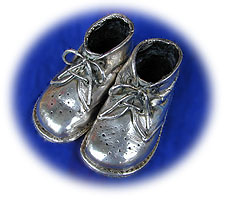
Path: Home Page > [About Myself >] Non-professional

![]() Let's start off with a little warning: The following text is a humorous article,
and if you are pressed for time, skip it. But, if you want some fun, wait for all the thumbnails to load. I have
chosen some unusual pictures from various places and events. I just can't understand why everyone shows the same
pictures. Paris: everyone shows the Eiffel Tower, Vienna: everyone shows Schönbrunn, Holland: everyone shows
the dams. Why?
Let's start off with a little warning: The following text is a humorous article,
and if you are pressed for time, skip it. But, if you want some fun, wait for all the thumbnails to load. I have
chosen some unusual pictures from various places and events. I just can't understand why everyone shows the same
pictures. Paris: everyone shows the Eiffel Tower, Vienna: everyone shows Schönbrunn, Holland: everyone shows
the dams. Why?
In the Beginning |
I was born in 1956. After that, nothing happened for a few years.
I have vague memories of myself as five or six years, getting old radios from my father, sitting on the slope outside the house, investigating their contents with hammers and other weaponry. The loudspeaker cone paper was especially nice to tear up.
The next bright memory is the chemistry lessons in junior high, and the one lesson that comes clearest to my mind is the day when the teacher pulled down the blinds and demonstrated oxygen-hydrogen gas in 25 litre plastic bottles on his desk. It banged and thundered, and long, yellow flames hit the ceiling. That awoke my interest for chemistry.
The next stop in my life was Swedish “gymnasiet” (~senior high school). I was probably a timid pupil, but it would be wrong to say that the name Städje passed unnoticed during my four years at the Västergårdsgymnasiet in Södertälje. Me and my friends were good-hearted. We did not pour butyric acid in the air conditioning system (because the air went the wrong way, so to speak) and we exploded no bombs on the school premises.
But we did do other things: we had our own “transmissions” over the loudspeaker system (not popular), found a hovercraft someone had built out of vacuum cleaner motors and hovered around the corridors, we started the tradition of having a tug-of-war with the other senior high across the Södertälje channel every year (the losing team had to jump in the sluice basin), we started the school magazine Watt-Anna Kuriren (after Watt-Anna, Water-Anne, a poor Södertälje woman from the turn of the century, carrying water for the rich families) and also started the tradition of having school revues at the last day of each spring semester.
 Sometime around my third year of senior high, calculators were available,
and allowed, in school. I waged the enormous sum of SEK 800 and bought an HP-25. Having a Hewlett-Packard you used
Reverse Polish Notation and demonstrated you were a real technician, and not one of those students of the natural
sciences who needed an “=” to understand that the equation was finished. One of the first owners of a calculator
at scool was our Mechanics teacher. He had a Sinclair, the kind that could use powers of ten, and that you had
to solder together yourself. Everyone in the classroom tested it, and when I got hold of it I tried a 1/0 and the
calculator broke. Of course HP handled the situation correctly, showing an “Err”
on the display.
Sometime around my third year of senior high, calculators were available,
and allowed, in school. I waged the enormous sum of SEK 800 and bought an HP-25. Having a Hewlett-Packard you used
Reverse Polish Notation and demonstrated you were a real technician, and not one of those students of the natural
sciences who needed an “=” to understand that the equation was finished. One of the first owners of a calculator
at scool was our Mechanics teacher. He had a Sinclair, the kind that could use powers of ten, and that you had
to solder together yourself. Everyone in the classroom tested it, and when I got hold of it I tried a 1/0 and the
calculator broke. Of course HP handled the situation correctly, showing an “Err”
on the display.
We made school revues, some sort of music hall, my friends and me. I don't know how I succeeded, but I probably have a lot of persuasive power, and I managed to borrow the biggest theatre in the town, complete with crew and all equipment for free, for one evening.
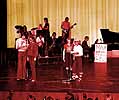 This is a stage shot, with the whole
cast appearing, from the 1976 revue. I am at the grand piano. The picture was originally black and white, but I
have colorized it. We were two friends, who spent several weeks writing the lyrics. Then we found an orchestra
with some happy musicians, and, without much rehearsing, and probably because of the theatre crew's great experience,
we got the show on the road in the end, anyway.
This is a stage shot, with the whole
cast appearing, from the 1976 revue. I am at the grand piano. The picture was originally black and white, but I
have colorized it. We were two friends, who spent several weeks writing the lyrics. Then we found an orchestra
with some happy musicians, and, without much rehearsing, and probably because of the theatre crew's great experience,
we got the show on the road in the end, anyway.
 All theatre companies
have their Prima Donna and First Charmer, and so had we. This is Lars-Göran, testing his physical strength
on Marie-Louise. Lars-Göran played saxophone and was a joker in general. Later in life, he made a computer-related
invention and became product manager at some big American company dealing with data storage. Nowadays he has his
own company. It seems we all go down the same road. Marie-Louise had a divine voice, but I don't know what happened
to her. All I know is that she went to the Mozarteum in Salzburg.
All theatre companies
have their Prima Donna and First Charmer, and so had we. This is Lars-Göran, testing his physical strength
on Marie-Louise. Lars-Göran played saxophone and was a joker in general. Later in life, he made a computer-related
invention and became product manager at some big American company dealing with data storage. Nowadays he has his
own company. It seems we all go down the same road. Marie-Louise had a divine voice, but I don't know what happened
to her. All I know is that she went to the Mozarteum in Salzburg.
We got good reviews in the newspapers, and the school management gave me flowers at breaking-up day. The called me “Primus motor” and something more, and I was very embarrassed. But now, twenty years later, when I listen to the tapes, I wonder if we were really sane. I specially remember that the grand piano had sharp corners on the keys, and that my fingers were bleeding after the show.
I managed one final practical joke before I left my torn and tattered school: I disassembled an oscilloscope in electronics class, and changed the X-deflection leads, so that the electron beam swept from right to left, and not from left to right as normal. I reckoned newcomers, not used to oscilloscopes, wouldn't notice this from the start, but as they progressed and started doing detailed analysis of wave shapes, there would be some very surprised faces. A joke I can recommend.
My school years finished happily with Intel inventing the microprocessor, and I could build my first Intel 8080 kit, the last year at senior high.
My educational career continued with a university degree in programming. That's where I learnt to type on a keyboard, because we programmed in COBOL on an IBM keypunch. After everyone had gone home, I usually remained, hacking my punch cards.
The school also had a mini computer of the Alpha LSI brand, featuring 32 kilobytes of core memory and some 20 MB of hard disk, on which we made our first, fumbling assembler attempts. At other times the machine usually ran multi-user BASIC. Today a PC has at least 32 megabytes of primary memory, but seldom takes more than one user at a time.
A friend of mine, who was actually in military service at the time, sometimes came to us in his spare time and used our Alpha LSI to learn programming. He was slightly too good. One morning he had found a command that erased the hard disk. We started off the morning with a long lesson in some other classroom and my friend had to read the whole BASIC-book fast as lightning, and after some two or three hours he had learnt enough to be able to restore the hard disk, without resorting to assembler. No one ever noticed anything. He was lucky all the files were contiguous!
Hobbies |
Since the time I had my first electron tube, I have had electronics in my blood. I still very well remember my first attempt to build a crystal receiver. It was some 30 years ago. I went to a radio shop and bought “a capacitor”. Aha, of what value? asked the technician. I had no idea, but he sold me a tubular ceramic capacitor. But alas, the design failed, because I didn't understand how to wind coils.
 Anyway I advanced fast. In junior high, I learnt how
to build simple amplifiers and in senior high everyone was building Hi-Fi. Me and a friend started designing a
power amplifier and sold the schematics. Some time later high frequency came into my life, I became a radio amateur
and took the call sign SMØFIX - Sugar Mike Zero Fox India X-ray. For some short period of time, a Swedish
postal order company sold microwave stuff, APX-6 surplus Identification Friend or Foe units from the American Air
Force. First we thought it was a typo in the catalogue: “Transceiver 1.5 GHz.” Perhaps it should have been “MHz?”
we thought, ordered the units and expected to get medium-wave transmitters.
Anyway I advanced fast. In junior high, I learnt how
to build simple amplifiers and in senior high everyone was building Hi-Fi. Me and a friend started designing a
power amplifier and sold the schematics. Some time later high frequency came into my life, I became a radio amateur
and took the call sign SMØFIX - Sugar Mike Zero Fox India X-ray. For some short period of time, a Swedish
postal order company sold microwave stuff, APX-6 surplus Identification Friend or Foe units from the American Air
Force. First we thought it was a typo in the catalogue: “Transceiver 1.5 GHz.” Perhaps it should have been “MHz?”
we thought, ordered the units and expected to get medium-wave transmitters.
 Pleasant feelings arose when we disassembled the units and really
found microwave cavities and lighthouse triodes. After having fast become autodidacts at twiddling microwave transmitters
and built the loveliest helical antennas, we could communicate at several hundred meters distance in the 1.2 GHz
microwave band. Maybe not very much of radio communication, but it saved our exam project in senior high. The picture
shows the schematics of a power amplifier for the microwave band I also tried my hands on. Later I gave my set
to an amateur radio astronomer.
Pleasant feelings arose when we disassembled the units and really
found microwave cavities and lighthouse triodes. After having fast become autodidacts at twiddling microwave transmitters
and built the loveliest helical antennas, we could communicate at several hundred meters distance in the 1.2 GHz
microwave band. Maybe not very much of radio communication, but it saved our exam project in senior high. The picture
shows the schematics of a power amplifier for the microwave band I also tried my hands on. Later I gave my set
to an amateur radio astronomer.
Exotica
The most exotic ham shack I have ever visited, was when I was -LY, that is in Lithuania in 1993. On the top floor of a 12-storey community centre (with a broken lift: “Njet rabota”) an amateur radio club had taken residence. I had noticed the antennas on the roof earlier, but this night I heard some mysterious UHF noise in the corridor. I ran fast out into the corridor and found a guy testing a handheld transceiver for the 2-metre band.
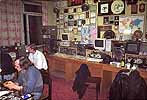 I introduced myself as a Swedish radio amateur
(probably the first foreign radio amateur he had seen after the fall of the Soviet Union in 1991) and he invited
me open-heartedly to his shack. The place was full of old Russian military surplus. My heart jumped several extra
beats. Receivskij and decodskij, and a terrible, homebrewed 2 kW short-wave power amplifier. The screening consisted
of chicken wire. Thou taketh what thou haveth!
I introduced myself as a Swedish radio amateur
(probably the first foreign radio amateur he had seen after the fall of the Soviet Union in 1991) and he invited
me open-heartedly to his shack. The place was full of old Russian military surplus. My heart jumped several extra
beats. Receivskij and decodskij, and a terrible, homebrewed 2 kW short-wave power amplifier. The screening consisted
of chicken wire. Thou taketh what thou haveth!
I couldn't understand what was on all the scales and knobs, but encouraged by his “Please, operate”, I twiddled a little here and there and made contact with an Englishman. The Englishman was also excited about a QSO from Lithuania, and so my day was saved. Later, all the Science Fiction enthusiasts who had originally invited me, came and found me, but at that time I was way to far sunken into the short-wave noise, to notice them.
But, what is left for radio amateurs today? Those who are not completely taken in by their radio equipment, or deal with something very exotic (like earth-moon-earth or comet-bouncing) have got alternatives. The short-waves were fun and worked sporadically, but today we have the Internet. The 2-metre and 70-centimetre people who use their handheld sets in their cars in the big cities, where there are repeaters, which work most of the time, nowadays have mobile phones, which work (slightly) more often.
Myself, I pity this development. The pioneering work that the radio amateurs did for our society has not been wasted, but the kind of development possible in the radio field today is so expensive, that few radio amateurs can afford it.
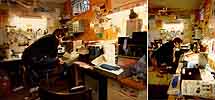 The microcomputers came into my life in the 1980's.
I have built things with Intel 8080 and 8086, as well as some Motorola. The picture shows what my electronic workshop
looked like at the time. The big picture shows, from the right, a stack of racks, from above, a standing power
supply, below this two black boxes: an eight inch and a five inch floppy drive, below them an open rack unit containing
the expansion bus with various extra circuit boards, and at the bottom, the CPU box with its orange LED's, showing
the status of the address and data buses. The blue keyboard is homebrewed.
The microcomputers came into my life in the 1980's.
I have built things with Intel 8080 and 8086, as well as some Motorola. The picture shows what my electronic workshop
looked like at the time. The big picture shows, from the right, a stack of racks, from above, a standing power
supply, below this two black boxes: an eight inch and a five inch floppy drive, below them an open rack unit containing
the expansion bus with various extra circuit boards, and at the bottom, the CPU box with its orange LED's, showing
the status of the address and data buses. The blue keyboard is homebrewed.
To the left, we see an oscilloscope that we used as a monitor. Ordinary monitors commanded astronomical sums at the time. Continuing left, we see standing an ASR 33 from Teletype Corporation, the kind of printing terminal that has lent its name to all “teletypes” henceforth. It rumbled and rattled but it worked well and printed nicely on paper, at some 11 characters per second! On top of that you could punch paper tape on it. Above it, you see the component storage. Further to the left, you may catch a glimpse of the right half of my homebuilt 8086 computer. You see it better in the small picture, where, in the foreground, you also see an eight inch floppy disk.
Today it is probably impossible to buy a capacitor in a radio shop...
 As developing and enlarging of black and white film and paper is so simple,
it is something one could (and should) start doing at young age. I inherited my grandfather's darkroom equipment,
and started nagging on my mother for blackout curtains. I was the one who always came dragging my camera and lights
to all school parties, making group photos, and soon enough they wouldn't let me in with my bags of cables and
lamps.
As developing and enlarging of black and white film and paper is so simple,
it is something one could (and should) start doing at young age. I inherited my grandfather's darkroom equipment,
and started nagging on my mother for blackout curtains. I was the one who always came dragging my camera and lights
to all school parties, making group photos, and soon enough they wouldn't let me in with my bags of cables and
lamps.
When I was older, I got a stronger economy and could change to colour photography and commercial development (see also the Gallery page). I have sold some framed enlargements to art clubs at various companies. What do you think is in the picture? UFOs landing? An invasion from an alien planet? Actually, it is street lamps in fog. But, everything grows boring: nowadays I mostly use PhotoShop and a scanner.
My parents forced me to take piano lessons in primary school, and I can assure you, it was no jumping for joy. Much later I understood the fun of improvised music and started playing jazz, voluntarily. The most traumatic experience I have ever encountered in the world of music, was the day when my father forced me to go to Södertälje Church to listen to something strange, that I didn't want to hear: “The Messiah” by Handel. They gave us text sheets, so I could follow the text. “Aha,” I thought, “with this speed it will all be over soon, and we can get out of here,” but to my unspeakable horror I discovered that the choir was repeating the text, over and over again!
 Father's archive of old 78-rpm's contained a lot, and soon I was travelling in the wonderful world of
music. I sniffed at various things, but soon I became stuck to Father Bach. Johann Sebastian Bach, this universal
genius of music, in front of whom everyone else fades, Mr. Handel too. Bach handled all genres and all styles and
he will never ever become boring. He can get rough-tough, tragic, softly romantic or flowing danceable. Why care
for anybody else? Johann Sebastian has it all.
Father's archive of old 78-rpm's contained a lot, and soon I was travelling in the wonderful world of
music. I sniffed at various things, but soon I became stuck to Father Bach. Johann Sebastian Bach, this universal
genius of music, in front of whom everyone else fades, Mr. Handel too. Bach handled all genres and all styles and
he will never ever become boring. He can get rough-tough, tragic, softly romantic or flowing danceable. Why care
for anybody else? Johann Sebastian has it all.
So, it may not seem strange that the first record of electronic music I bought is the one I cherish the most: Walter Carlos' “Switched-on Bach!”
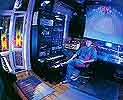 Among the contemporary, now living musical artists,
it is only our own grandfather of synthesisers, Ralph Lundsten that I find it worth the effort spending listening
time on. He masters the art of always being “new” and never repeating a melody to make it boring. Furthermore,
our Nordic nature stands very clear in his music. You'll find a link to his home page here.
There, he can boast about himself.
Among the contemporary, now living musical artists,
it is only our own grandfather of synthesisers, Ralph Lundsten that I find it worth the effort spending listening
time on. He masters the art of always being “new” and never repeating a melody to make it boring. Furthermore,
our Nordic nature stands very clear in his music. You'll find a link to his home page here.
There, he can boast about himself.
Travelling |
London and England have always been close to my heart. The English is a special kind of people, kind, helpful and very English in general (at least the ones I have met). How many times I have been to London, I cannot remember.
 However, the first time was in 1980, when I went there
with my programming class. Among others, we visited the company Logica, which had designed a graphic display system
with the latest circuits from Intel. We were shown the fast (green) vector graphics and we were duly impressed.
However, the first time was in 1980, when I went there
with my programming class. Among others, we visited the company Logica, which had designed a graphic display system
with the latest circuits from Intel. We were shown the fast (green) vector graphics and we were duly impressed.
We also went out to ICL's large complex somewhere outside London, and saw their big hall used for final inspection of mainframe computers. I had never seen so much cabling in one and the same place. We were only allowed to walk around the immense hall in corridors and view the goings on through panorama windows. The corridors housed the communications equipment, and I especially remember the enormous amount of ASR 33's. In the evening we went to Music Hall and after the performers had finished, I asked the management if I could be allowed to play a few songs. They had nothing against it, and there's where this picture comes from.
It sometimes rains in London. There is some truth to the expression "it rains cats and dogs". That's exactly what it did one day in 1981, as a friend and me were walking in the area around Waterloo Station. Suddenly we were attacked by rain so forceful the umbrella was rendered useless. It rained straight through. People came rushing up from the subway station close by, because it was filling up with water. The streets were flooded.
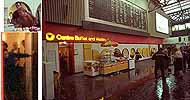 We took refuge in Waterloo Station. Inside,
people stood, contemplating their wet clothes. Everything was dry, until a glass pane in the roof broke, and a
thick jet of water landed in the middle of the ice-cream stand. The exposure time of this picture is too long to
make the water stand out clearly, but you can see the cloud of water around the freezer. The upper insert shows
the ice cream man, the one under the parasol, rushing towards his freezer, that is quickly filling up. The lower
insert shows and elderly lady on her way out from the waiting room, hurtling herself backwards to avoid the water
jet (motion blur). Also note the disturbed faces in the room behind her.
We took refuge in Waterloo Station. Inside,
people stood, contemplating their wet clothes. Everything was dry, until a glass pane in the roof broke, and a
thick jet of water landed in the middle of the ice-cream stand. The exposure time of this picture is too long to
make the water stand out clearly, but you can see the cloud of water around the freezer. The upper insert shows
the ice cream man, the one under the parasol, rushing towards his freezer, that is quickly filling up. The lower
insert shows and elderly lady on her way out from the waiting room, hurtling herself backwards to avoid the water
jet (motion blur). Also note the disturbed faces in the room behind her.
 There are lots of things to tell about London: the
wonderful little electronics shops along Edgware Road, Shepherd's Pie and all the lovely things on the pubs, lying
on your stomach, doing nothing, in Hyde Park, bathrooms with wall to wall carpets but without a drain, and so on,
but I will refrain from that. Let it suffice to recall the following conversation, which I happened to overhear
at Foyle's, the world's largest book shop. A customer was asking a shop assistant something:
There are lots of things to tell about London: the
wonderful little electronics shops along Edgware Road, Shepherd's Pie and all the lovely things on the pubs, lying
on your stomach, doing nothing, in Hyde Park, bathrooms with wall to wall carpets but without a drain, and so on,
but I will refrain from that. Let it suffice to recall the following conversation, which I happened to overhear
at Foyle's, the world's largest book shop. A customer was asking a shop assistant something:
- “The Meaning of Life?” That will be the Philosophy section over there, Madam.
The customer says something more.
- Aha, “The Meaning of Liff!” That's the humour section over there!
 That St. Paul's Cathedral made it through the Second World
War bombings, is a miracle. It's a building that I can see over and over again. This is what the ceiling looks
like. Isn't it nice?
That St. Paul's Cathedral made it through the Second World
War bombings, is a miracle. It's a building that I can see over and over again. This is what the ceiling looks
like. Isn't it nice?
 My doings in Vienna has become quite extensive
lately, so the Vienna-isms are now located in a Vienna Gallery.
My doings in Vienna has become quite extensive
lately, so the Vienna-isms are now located in a Vienna Gallery.
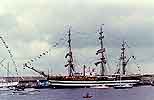 I happened to be in Rotterdam in Holland just as the
Tall Ships Race was about to start. The picture shows the Russian sailing ship Kreuzenstern, a fantastically beautiful
boat. The Rotterdam harbour in itself is a fantastic structure, some 20 kilometres long and full of boats, cranes
and containers all the way.
I happened to be in Rotterdam in Holland just as the
Tall Ships Race was about to start. The picture shows the Russian sailing ship Kreuzenstern, a fantastically beautiful
boat. The Rotterdam harbour in itself is a fantastic structure, some 20 kilometres long and full of boats, cranes
and containers all the way.
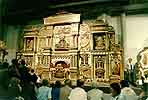 Holland is the promised land of self-playing
instruments (like Switzerland, but in Sweden we always think of Holland) and in Utrecht you'll find the “National
Museum from Musical Clock to Street Organ,” in which we saw a number of fantastic machines from the previous century.
The first picture shows an automatic orchestra, a combination of organ, various drums, xylophone and more. It played
from a cardboard tape 30 centimetres wide and when it started, it was so loud that little children fell backwards
from the euphony.
Holland is the promised land of self-playing
instruments (like Switzerland, but in Sweden we always think of Holland) and in Utrecht you'll find the “National
Museum from Musical Clock to Street Organ,” in which we saw a number of fantastic machines from the previous century.
The first picture shows an automatic orchestra, a combination of organ, various drums, xylophone and more. It played
from a cardboard tape 30 centimetres wide and when it started, it was so loud that little children fell backwards
from the euphony.
 The next picture shows a piano with a violin attachment.
Player pianos may not be very unusual, but the violin was quite interesting. Actually there were three violins,
encircled by a continuously rotating, continuous bow. When a violin should sound, it was pressed against the bow,
and a number of pneumatic fingers on its neck pressed the strings down. A masterpiece in wood and horsetail.
The next picture shows a piano with a violin attachment.
Player pianos may not be very unusual, but the violin was quite interesting. Actually there were three violins,
encircled by a continuously rotating, continuous bow. When a violin should sound, it was pressed against the bow,
and a number of pneumatic fingers on its neck pressed the strings down. A masterpiece in wood and horsetail.
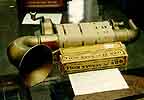 The last picture shows a self-playing saxophone,
a personal instrument. Note the clockwork box that drives the music roll. Also note that the Q.R.S. company that
made the music roll, still exists and still makes some hundred thousands of rolls per annum, for various mechanical
self-playing instruments.
The last picture shows a self-playing saxophone,
a personal instrument. Note the clockwork box that drives the music roll. Also note that the Q.R.S. company that
made the music roll, still exists and still makes some hundred thousands of rolls per annum, for various mechanical
self-playing instruments.
Together with a friend I went to Bahrain, an autonomous country on a little island in the Persian Gulf, connected to Saudi Arabia by a long motorway bridge, to find out if there were any good jobs there. The conditions were wonderful for us westerners, no rain ever, no taxes, free hospital care, and the price of a hamburger was about 50 pence. Although not so wonderful for the poor, immigrated Indian guest workers...
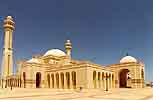
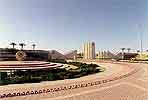 There were no
good jobs, but there were lots of exciting things to see. Let's start with the monuments. The first picture shows
the largest mosque in Manama, the Al Fateh, a monument to which even I, an inveterate heathen, fall in due deference.
Something of the most beautiful I have ever seen. The next picture shows the gates to Manama University. Try outdoing
that if you can, Stockholm University. And this was only the door!
There were no
good jobs, but there were lots of exciting things to see. Let's start with the monuments. The first picture shows
the largest mosque in Manama, the Al Fateh, a monument to which even I, an inveterate heathen, fall in due deference.
Something of the most beautiful I have ever seen. The next picture shows the gates to Manama University. Try outdoing
that if you can, Stockholm University. And this was only the door!
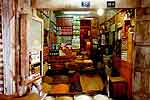 The Bazaar! This very word brings a fragrance
of mystique to us shopping-centre-lulled boring-Swedes. You expect flying carpets and 40 robbers in pots in every
corner, but that's not the way it is. The Suk, the Manama bazaar, was a veritable jumble of microscopic shops,
selling everything between heaven and earth, mostly imported low price stuff from East Asia, about the same mixture
of goods as you can get in the postal order catalogues “fantastic offers” at home in Sweden.
The Bazaar! This very word brings a fragrance
of mystique to us shopping-centre-lulled boring-Swedes. You expect flying carpets and 40 robbers in pots in every
corner, but that's not the way it is. The Suk, the Manama bazaar, was a veritable jumble of microscopic shops,
selling everything between heaven and earth, mostly imported low price stuff from East Asia, about the same mixture
of goods as you can get in the postal order catalogues “fantastic offers” at home in Sweden.
There were cloth-shops filled all the way up to the ceiling with wonderful silk, and a little old lady in one corner with a sewing machine, the Gold Street showed rows upon rows with little shops selling gold, gold and more gold. And finally, the mystique of the Orient itself: the spices. The picture shows a typical spice shop, with pepper, curry, paprika, fennel, tamarind et cetera, in small, nicely made pyramids. The Arabs around me started laughing as I was focusing my camera, and wondered why I wanted to photograph a shop with no one in it.
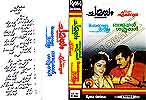 The Indian music shops deserve to be mentioned
specially. Film music is a big thing for the Indians and with such a large contingent of Indians in the city, there
were lots of shops where you could buy only music cassettes with Indian film music. A typical shop would be the
size of an ordinary Swedish kitchen, but would have the walls dressed from floor to ceiling with music cassettes.
Not one millimetre wasted. At the desk was the shop owner pirate copying like crazy. In the window, the typical
Indian film posters: Baaad, big, strong thing with a cudgel, threatening a woman, praying on her knees. In the
background 1 pcs. hero comes running with a gun. Pretty fun music, for a while.
The Indian music shops deserve to be mentioned
specially. Film music is a big thing for the Indians and with such a large contingent of Indians in the city, there
were lots of shops where you could buy only music cassettes with Indian film music. A typical shop would be the
size of an ordinary Swedish kitchen, but would have the walls dressed from floor to ceiling with music cassettes.
Not one millimetre wasted. At the desk was the shop owner pirate copying like crazy. In the window, the typical
Indian film posters: Baaad, big, strong thing with a cudgel, threatening a woman, praying on her knees. In the
background 1 pcs. hero comes running with a gun. Pretty fun music, for a while.
 Without clouds, the evenings will always be
beautiful. This picture is taken from inside the Suk towards a square outside. Not bad, if I may say it myself.
Without clouds, the evenings will always be
beautiful. This picture is taken from inside the Suk towards a square outside. Not bad, if I may say it myself.
 |
“Lübeck was full of junk”, my friend Nils commented this picture. Of course, it doesn't do Lübeck justice, but it sure was strange to find a dump in the middle of the city. |
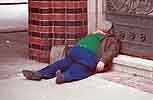 |
Commerce was a-bustling outside the Raathaus (City Hall) and lots of people passed all the time. One who didn't pass, but rather had passed out, was this gentleman. He was finished passing for today, thank you. Very close to this spot was the Raathauskeller restaurant. Perhaps he had been there? I could go on showing a lot of pictures of churches and stained glass windows. But I won't. Instead you might want to watch the Lübeck pictures in the Photo Gallery. |
Apart from attending courses in Switzerland, I travelled around in the Alps some. Among other things, I went by mountain railroad, you know those that pull themselves forward by cogwheel. The train departed from Montreux, the city everyone probably remember from the European Song Contests. It looks just like any industrial city. The train went up to Gstaad, the winter-show-off city of the rich. Gstaad looks just like a scene out of the Sound of Music. It was here that James Bond blew up a restaurant in the film "Diamonds are Forever". The beer mugs and beefs were quite large.
 On its way up, the train ran into a cloud.
It was like going through milk. After some time we came out of a tunnel, far above the clouds. To the right was
the most beautiful mountain view I had ever seen, and I have never heard so many camera shutters go off at the
same time. I took some pictures too. The picture above left was black and white, but I colorized
it later, in PhotoShop.
On its way up, the train ran into a cloud.
It was like going through milk. After some time we came out of a tunnel, far above the clouds. To the right was
the most beautiful mountain view I had ever seen, and I have never heard so many camera shutters go off at the
same time. I took some pictures too. The picture above left was black and white, but I colorized
it later, in PhotoShop.
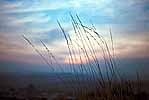 An unusually relaxed evening picture,
made on a hill outside Lausanne. I don't remember any more why I was on that hill at that time, maybe it was because
the others were out for a bit of a wee-wee. I decided to go on a photo safari instead.
An unusually relaxed evening picture,
made on a hill outside Lausanne. I don't remember any more why I was on that hill at that time, maybe it was because
the others were out for a bit of a wee-wee. I decided to go on a photo safari instead.
The U. S. |
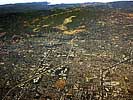 |
For some reason I have always ended up in Californa in the U. S. But, the weather is good, the hamburgers big and people are friendly. I have made a few trips now, and they have got their own, Californian Gallery. |
Östersund, Sweden |
I spent one short holiday in the town of the Swedish national composer Wilhelm Peterson-Berger, Östersund. We made the compulsory excursion to Frösö Island and walked on his summer meadow, saw all the meadow flowers and found out where he got his inspiration from. We were at his Frösö Church too. Everything was calm and wonderful.
But, what made the deepest impression on me, was the open air museum at Gudmundstjärn in Indal. The farm at Gudmundstjärn was one of Sweden's last self-subsistent households when it was abandoned in the 1940's. The people living there, Tjärnfolket, had been resident, worked, built and strained at the same place for 165 years, almost completely isolated from all civilisation, from the 18th century all the way into the 20th century. We were told the history of the self-subsistent household at Gudmundstjärn and the extremely hard life these industrious people were forced to live for several generations. It is more or less impossible to understand their hardship and the enormous energy they had. They built their houses themselves, their sawmill, their machinery, their ovens etc.
 The woman Sara Lena Nilsdotter (1833-1928)
who lived until she was 95 years, must have been a remarkable person. Despite having her hand molested by a harvester,
she worked all her life. She built the oven of the house, she built her own loom et cetera, et cetera.
The woman Sara Lena Nilsdotter (1833-1928)
who lived until she was 95 years, must have been a remarkable person. Despite having her hand molested by a harvester,
she worked all her life. She built the oven of the house, she built her own loom et cetera, et cetera.
The unfathomabillity of this situation is too big for me to continue telling. If you can read Swedish, please buy the book “Tjärnfolket” by Hans-Olof Jonsson (ISBN 91-7260-653-3) and read for yourself.
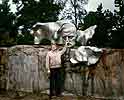 Helsinki is a beautiful city, one that should
be visited often. It has not been torn down and modernised like Stockholm. The department stores are more elegant,
and the Fazer chocolate restaurant has no counterpart in Stockholm. The Helsinki railway station is beautiful,
as distinguished from the one in Stockholm. This picture shows me at the monument of the Finnish national composer
Jean Sibelius. Maybe you think I don't show him enough respect? Do you have to show respect at national monuments?
Can't I like Sibelius' music anyway?
Helsinki is a beautiful city, one that should
be visited often. It has not been torn down and modernised like Stockholm. The department stores are more elegant,
and the Fazer chocolate restaurant has no counterpart in Stockholm. The Helsinki railway station is beautiful,
as distinguished from the one in Stockholm. This picture shows me at the monument of the Finnish national composer
Jean Sibelius. Maybe you think I don't show him enough respect? Do you have to show respect at national monuments?
Can't I like Sibelius' music anyway?
There is more about Helsinki in the Finnish Gallery.
After having spent 13 hours in a sleeping train from Stockholm, we reached Boden (far north of the arctic circle). Deep snow. Deserted. Very fun. A few hours by car, and we were in Rovaniemi. It looked like any other large city, except for the snow sculptures along the main street. One day we were supposed to be alpine tourists and go snowmobiling. After that, I had no problems understanding why there are so many snowmobile accidents in the Swedish alps every year. A snowmobile weighs about 200 kilos and runs 110 kilometres per hour. You sit completely unprotected, and if the snowmobile turns over, you become squashed. And since the policemen are thinly distributed up there, people drive like crazy. So did we.
The Fins assert for sure, that Father Christmas lives in Rovaniemi, and our first stop was the Father Christmas Village, built especially for the American tourists, which is a shopping centre in the middle of the forest with a little Christmas touch and nothing more. Why the Americans fly the Concorde up there and go shopping, I just can't understand. It probably has something to do with marketing...
 The next stop was a “genuine” Lappi village.
If you could manage to hang on to a reindeer, sitting on a plank at full speed, you got a reindeer drivers license.
(I have purposely made my signature unreadable, because I don't want it spread around the Internet. Except for
that, it's genuine.)
The next stop was a “genuine” Lappi village.
If you could manage to hang on to a reindeer, sitting on a plank at full speed, you got a reindeer drivers license.
(I have purposely made my signature unreadable, because I don't want it spread around the Internet. Except for
that, it's genuine.)
Having been shown the touristified Lappi village and gone sleighriding down a hill as all the other tourists, we had the opportunity to experience something different, something outstanding.
The shaman, the village magician, took us to a special ceremonial teepee, where we took part in a fertility ceremony. Reindeer's milk mixed with powdered reindeer horn is said to give better potency and the like, and we fidgeted a little, the ladies giggled, worried, wondering what would happen at the hotel later in the evening. The shaman rose and went around to all of us, offering the sweet milk, and from everyone who drank, he cut a little snippet of hair with his Lappi knife.
Then I had shivers down my back, because I suddenly understood the ancient magic and how life worked in the Lappi village. The chief had power over daily life, and could judge and rule over life, while the shaman had power over life and death. Just as he could cut a snippet of my neck hair, he could have cut somewhere else, to show his power over death. In the old days the shaman of course was omnipotent.
The shaman read some ceremonial words over the hair snippets, and we could get out into the Lapp country again. I definitely gained something by that experience.
Literature |
“Fahrenheit 451” was the first try with a new and heavy drug, which I haven't been able to free myself from later: Science Fiction (SF).
SF conventions are something you can not avoid, if you devote your life to SF. Being a technician, I initiated the build-up of the Swedish peanut defence, the PDI (Peanut Defence Initiative), a techno-heavy competition, which was held on various SF conventions in Stockholm, for a number of years. This competition, which of course had its roots in some similar tradition in the US, was all about transporting a peanut (with outer shell) 2 metres in the most high tech possible way. Of course you could just throw the nut by hand, but you would loose lots of points for style.
After SAFA (the Swedish Academy For Algorithm research) decided to take part in The Great Peanut Race, we won the competition every year, until we left it. We left because the technological effort needed to outdo the technological effort from last year, finally became to great. Other participants tried less high ranking technological methods, such as shooting the nut taped to a firework rocket (indoors, it flew in under someone's skirt), run it on a model railway, spurt lots of nuts through a big fan, and shoot a peanut with a town gas explosion (PET bottles are strong).
SAFAs first effort, the PDI/1 (Peanut Defense Initiative), consisted of an electromagnetic gun, with which we, using energy stored in a battery of capacitors, shot a projectile made from a plastic bottle wound with a copper coil, out of a magnet taken from an old disk drive belonging to a mainframe computer. We had a bang and a flash, and the two metres were covered without problems.
For the NASACON 1988 our brains gave birth to a yet more devilish method of throwing and disintegrating vegetables. The PDI/2 project was much more complicated and consisted of a big DC motor with associated drive electronics, with a spoon fastened across its shaft. With the proper control software the spoon could throw a peanut almost any distance. The night before the competition we manufactured a motorised peanut feeder, because we wanted to be able to fire automatically. After testing various feeder types, the peanut revolver emerged as the best alternative.
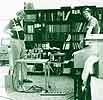 Shown here is some heavy development work
going on, with the electromechanical part of the peanut accelerator. The author is standing to the left, and to
the right is Thord Nilson, the hardware guru. As you can see, the reference library in the background is quite
extensive.
Shown here is some heavy development work
going on, with the electromechanical part of the peanut accelerator. The author is standing to the left, and to
the right is Thord Nilson, the hardware guru. As you can see, the reference library in the background is quite
extensive.
 The controller software, including a semi-graphical
user interface with a menu system, synthetic speech and launch logic, was developed in only a few days on a 8 MHz
8086 PC of the Victor VPC 2 brand, a long time before sound boards, multimedia systems, production-increasing integrated
development environments, Microsoft Foundation Classes and object orientation, something that would have taken
any major consultancy firm several months. Sometimes enthusiasm outweighs committee meetings. It is the internationally
well known programming giant Nils Segerdahl who is letting his magic fingers play on the keyboard.
The controller software, including a semi-graphical
user interface with a menu system, synthetic speech and launch logic, was developed in only a few days on a 8 MHz
8086 PC of the Victor VPC 2 brand, a long time before sound boards, multimedia systems, production-increasing integrated
development environments, Microsoft Foundation Classes and object orientation, something that would have taken
any major consultancy firm several months. Sometimes enthusiasm outweighs committee meetings. It is the internationally
well known programming giant Nils Segerdahl who is letting his magic fingers play on the keyboard.
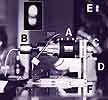 A close-up of the peanut accelerator, showing
its design details. A is the motor. B is an angular and rpm sensor used for checking the motor's speed of revolution
and its exact angle of rotation. The spoon is mounted at C. D is the spoon bowl, having thrown the peanut, E, up
into the air just moments ago. The stand, F, welded by the author, had to be fastened to the table, as it would
otherwise fast fly away. The insert shows the peanut in the moment of flight, image enhanced to clarify its surface
structure. At the left, on the stand, is a water-level. If the construction would not be entirely horizontal, the
spoon would miss the projectiles. The revolver feeder is not visible in the picture.
A close-up of the peanut accelerator, showing
its design details. A is the motor. B is an angular and rpm sensor used for checking the motor's speed of revolution
and its exact angle of rotation. The spoon is mounted at C. D is the spoon bowl, having thrown the peanut, E, up
into the air just moments ago. The stand, F, welded by the author, had to be fastened to the table, as it would
otherwise fast fly away. The insert shows the peanut in the moment of flight, image enhanced to clarify its surface
structure. At the left, on the stand, is a water-level. If the construction would not be entirely horizontal, the
spoon would miss the projectiles. The revolver feeder is not visible in the picture.
The thrower used several different movements:
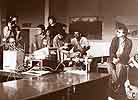 Convention participants during the NASACON,
beholding the winning throw. To the far left is our Swedish SF giant, Mr. Sam J. Lundwall. After our competition
entry had filled up the hall with peanut shrapnel, the mass of audience cheered and awarded us the gold medal.
Convention participants during the NASACON,
beholding the winning throw. To the far left is our Swedish SF giant, Mr. Sam J. Lundwall. After our competition
entry had filled up the hall with peanut shrapnel, the mass of audience cheered and awarded us the gold medal.
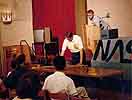
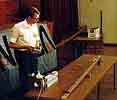 The LIPAC 1600/27, Linear Peanut Accelerator
was one of the most complicated projects I have taken part in. The enumeration designates the length: 1600 millimetres,
and the fact that it had 27 poles. In just one night SAFA built a maglev railway. Of course, it helped to have
all the resources of Atlas Copco's development department at hand, but anyway, getting a 1.5 metre three-phase
linear motor together, with your bare hands, in only one night, is not bad. The pictures show the moment of competition,
while a friend of mine is handling the equipment, and yours truly describing its virtues from the stage, using
laterna magica. There is more information available, if you follow the link to SAFA.
The LIPAC 1600/27, Linear Peanut Accelerator
was one of the most complicated projects I have taken part in. The enumeration designates the length: 1600 millimetres,
and the fact that it had 27 poles. In just one night SAFA built a maglev railway. Of course, it helped to have
all the resources of Atlas Copco's development department at hand, but anyway, getting a 1.5 metre three-phase
linear motor together, with your bare hands, in only one night, is not bad. The pictures show the moment of competition,
while a friend of mine is handling the equipment, and yours truly describing its virtues from the stage, using
laterna magica. There is more information available, if you follow the link to SAFA.

 After having received severe
Heinlein damage in younger days, and the doctors declared I had Arthur C. Clarke's syndrome in my right brain hemisphere,
I found The Lord of the Rings. After that, it was all over. We started Haradrim, the Tolkien & Fantasy Society
of Södertälje, Sweden. Since then I am a Tolkienist.
After having received severe
Heinlein damage in younger days, and the doctors declared I had Arthur C. Clarke's syndrome in my right brain hemisphere,
I found The Lord of the Rings. After that, it was all over. We started Haradrim, the Tolkien & Fantasy Society
of Södertälje, Sweden. Since then I am a Tolkienist.

 As often as possible,
I try to visit all the parties of the other Tolkien Societies around the country, but probably with happiest heart
the yearly Angmar (The Tolkien Society of Malmoe, Sweden) Beechwood Fiest. You go there to live in tents under
primitive conditions, collect around the campfire to sing Tolkienistic songs, have a beer in the forest discotheque
(the animals of the forest, on the other hand, probably stay far away) and during the finishing ceremonies,
try to come out on top of the other societies invited, in giving the most ingenious present to the High Council
of Angmar. Presents making holes in the roof and walls are accepted, but the Council has voiced a wish that they
may never see the same prank in the future. The first picture shows the Malmoe, Södertälje and Stockholm
Tolkien Societies engaging in destructive testing of the H.C. Andersen statue at Råhuspladsen (City Hall
Square) in Copenhagen after a very successful Beechwood Fiest. You can make out the hat and one shoulder. The next
picture shows the bold knights Foogol and Adil of Haradrim demonstrating an Eyes-box, a gift for the High Council
of Angmar, a microcomputer controlled miracle with eyes of various colours, blinking and pulsating in a threatening
manner whenever the box is opened.
As often as possible,
I try to visit all the parties of the other Tolkien Societies around the country, but probably with happiest heart
the yearly Angmar (The Tolkien Society of Malmoe, Sweden) Beechwood Fiest. You go there to live in tents under
primitive conditions, collect around the campfire to sing Tolkienistic songs, have a beer in the forest discotheque
(the animals of the forest, on the other hand, probably stay far away) and during the finishing ceremonies,
try to come out on top of the other societies invited, in giving the most ingenious present to the High Council
of Angmar. Presents making holes in the roof and walls are accepted, but the Council has voiced a wish that they
may never see the same prank in the future. The first picture shows the Malmoe, Södertälje and Stockholm
Tolkien Societies engaging in destructive testing of the H.C. Andersen statue at Råhuspladsen (City Hall
Square) in Copenhagen after a very successful Beechwood Fiest. You can make out the hat and one shoulder. The next
picture shows the bold knights Foogol and Adil of Haradrim demonstrating an Eyes-box, a gift for the High Council
of Angmar, a microcomputer controlled miracle with eyes of various colours, blinking and pulsating in a threatening
manner whenever the box is opened.
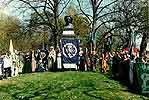 Every spring, Forodrim, The Stockholm Tolkien
Society and others, parade through the streets of Stockholm in a festivity called The Gates of Summer. Usually
some one hundred people show up, dressed in full Tolkien costume, often led by a bagpipe band and mounted police,
parade through the most popular shopping streets of the city, to the tourists' great amusement. We walk on to the
Royal Djurgården Park and sit down by the statue of Bellman (a great poet from the 18th century) to consume
our rations, fight with mace and perform other enjoyabilities. Haradrim holds the right flank in the picture. But
of course we don't drink any alcohol this day. That's not allowed in the Royal Djurgården.
Every spring, Forodrim, The Stockholm Tolkien
Society and others, parade through the streets of Stockholm in a festivity called The Gates of Summer. Usually
some one hundred people show up, dressed in full Tolkien costume, often led by a bagpipe band and mounted police,
parade through the most popular shopping streets of the city, to the tourists' great amusement. We walk on to the
Royal Djurgården Park and sit down by the statue of Bellman (a great poet from the 18th century) to consume
our rations, fight with mace and perform other enjoyabilities. Haradrim holds the right flank in the picture. But
of course we don't drink any alcohol this day. That's not allowed in the Royal Djurgården.

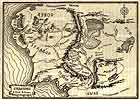 A rarity, the very first official print of The Lord of The Rings in Russian, published in Lithuania
in 1991 (ISBN 5-7183 0003-8). The Lord of The Rings had been “published” earlier as typewritten samizdat, in a
least three, not very good translations. The Communist Party had the book banned, because they could not tolerate
a book about any other country than the Soviet Union, and Mr. Tolkien was definitely no good Communist. The next
picture shows the map of Middle-Earth in Cyrillic. I have translated some of the names in white letters.
A rarity, the very first official print of The Lord of The Rings in Russian, published in Lithuania
in 1991 (ISBN 5-7183 0003-8). The Lord of The Rings had been “published” earlier as typewritten samizdat, in a
least three, not very good translations. The Communist Party had the book banned, because they could not tolerate
a book about any other country than the Soviet Union, and Mr. Tolkien was definitely no good Communist. The next
picture shows the map of Middle-Earth in Cyrillic. I have translated some of the names in white letters.
 Here you see the very first page of the book,
the one that in English begins with “When Mr. Bilbo Baggins of Bag End announced that he would shortly be celebrating
his eleventyfirst birthday with a party of special magnificence, there was much talk and excitement in Hobbiton.”
Here you see the very first page of the book,
the one that in English begins with “When Mr. Bilbo Baggins of Bag End announced that he would shortly be celebrating
his eleventyfirst birthday with a party of special magnificence, there was much talk and excitement in Hobbiton.”

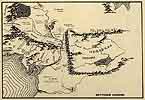 Perhaps even rarer, is the first Lithuanian issue of The Lord of the Rings, printed in
1994 in Vilnius, printed a few years after the fall of Communism, when the country's economy had been restored
(ISBN 9986-02-038-7). The work contains only the First Book, because Andrius Tapinas only have had time enough
to translate one book yet (1988). The translation is regarded as very good. The Lithuanian map shows the best part
of Middle-Earth, the part with Mordor and Harad.
Perhaps even rarer, is the first Lithuanian issue of The Lord of the Rings, printed in
1994 in Vilnius, printed a few years after the fall of Communism, when the country's economy had been restored
(ISBN 9986-02-038-7). The work contains only the First Book, because Andrius Tapinas only have had time enough
to translate one book yet (1988). The translation is regarded as very good. The Lithuanian map shows the best part
of Middle-Earth, the part with Mordor and Harad.
 Here is the first page of the book, the
same as above, for comparison. Maybe it is not very decorated or beautiful, but it's functional. It is better that
people get to read this wonderful story, than not at all.
Here is the first page of the book, the
same as above, for comparison. Maybe it is not very decorated or beautiful, but it's functional. It is better that
people get to read this wonderful story, than not at all.
Lithuania |
||
| In 1992, only one year after the Soviet occupation forces were thrown out, the first SF convention we visited, was held in our, to that day completely unknown, neighbouring country Lithuania. Four merry men took the ferry to Tallinn in Estonia, rented a car, and thus started our life's enthusiasm for this (until then) white spot on our maps. There was a lot to discover. | ||
Late-late history |
||
| Communism had started to soften already in the middle 80's, and the border states took greater and greater liberties. Vytautas Landsbergis, later to become the first democratic president, applied for Lithuania's withdrawal from the Soviet Union in 1991. The Soviet law said that the republics had their free will to withdraw their membership, but no one had ever thought of doing it, because if he tried he was guaranteed to be shot by the KGB. As there were now so many anti-Soviet currents, this article of the law was to be scrapped. Mr. Landsbergis handed in the request only two hours before the article was invalidated, and had it accepted, in full accordance with the law. You could say it was Mr. Landsbergis who finally toppled the Soviet Union. | ||
| In 1991 Mikhail Gorbachev received the Nobel Peace Prize. Six days later, he had his tanks rolling through Vilnius and a coup d'etat was feared. Of course, Lithuania was close to his heart (that part of his heart labelled “If you stick your chin out, I'll punch it”) because he had been the former chief guardian for the republic. He would not let the granary of the Soviet Union go to waste without a fight. The picture shows Nepriklausomybes (Independence Square) in 1992, with the Parliament House still barricaded by concrete cases, as new attacks was feared all the time. There were thousands of people around the Parliament night after night, having only their bodies to counter the Soviet tanks. At the middle of the house is a memorial for those who didn't survive. | ||
| Those who stood on the square in January 1991 were only waiting for the tanks to come rolling over them, in the
old, well known, Soviet manner, or for the Alpha Squad to be deployed. It is believed that only four memebers of
the squad have ever died in battle, plus a fifth who died when the squad was used to “free” the audience in the
Dubrovka Theatre in Moscow in October 2002 after a group of Chechens took the whole theater as hostage, demading
an end to the war in Chechnya. Alpha used a deadly gas to kill 190 innocent people, many more than the five shot
by the Chechens. Alpha's only task was to save the president's face, in this case the former KGB office Vladimir
Putin, using any available means. Not that here is very much of a face to save for the man who leisurely played golf while hundreds of mariners drowned in the submarine Kursk in 2000, and that would releaase the composition of the gas used only after five days, when it was guaranteed that everyone who could tell on them, were dead. But, as the Chechen leader said: “You don't even show mercy on your own people, why should we expect any mercy? We came here to die.” |
||
| The Red Army however, made the fatal mistake of fighting in front of running TV cameras, and against a very decided population. It is rumoured that president George Bush of the United States held back the Gulf War for a week, so the world would not loose interest in little Lithuania. The picture shows the TV tower in Vilnius, around which some very severe fighting between drugged Soviet tank drivers and unarmed civilians took place. In all 14 persons were shot or run over by tanks. We are standing in front of the memorials, consisting of the typically Lithuanian “totem poles” with inscribed commemorative words. | ||
Pick-nick on an ICBM Silo |
||
| A unique image document from the ex-Soviet ICBM base in Telsiai in Lithuania. The base is closed down and deserted and all the ICBMs have been removed. At the time of this visit in 1997 one family, who would guide people around for a fee, guarded the base. | ||
| Of course people have been breaking in and looting the base of all loose items, but still it is easy to understand the terrible circumstances that the personnel had to live by. Everything very cramped, badly built installations, loose wires hanging from the roof and ticking, leaking atomic bombs in every hole and corrosive rocket fuel. Also notice the family sitting on the lid of the ICBM silo, check out the substandard lid and the badly smeared tar on the concrete dome. The installation decayed into this shape in only 6-7 years without maintenance. Do you think this installation would have worked if things had gone serious? And where did the Russians dump the rockets? Photo: Dangira Griksiene | ||
The Museum of Devils |
||
| Kaunas has a Devil's Museum. It contains the collections of Antanas Zmuidzinavicius, a man who spent his life collecting images of devils. There are riding devils, lying devils, flying devils and devils caged. Additionally there are devil's masks and devil's accessories. This museum must be completely unique, and should be visited by anyone travelling to Kaunas. | ||
Science Fiction |
||
| SF had problems during communism, because it expressed a future other than the one ratified by the Party. No one wanted to read Communist-ratified SF. When communism disappeared, the SF clubs jumped up like mushrooms everywhere in the eastern bloc. There must have been more jumping in Lithuania than anywhere else. You will find more information about Club Dorado and Lithuanian SF here. | ||
| Our trip through Estonia, Latvia and Lithuania wasn't very adventurous, apart from the navigation being severely hampered by the lack of road signs and the police force's interesting method of enforcing local speed reductions, by putting the signs down the ditch and then fining everyone who didn't see them. SF people are used to beer testing, and the Lithuanian beer was scrupulously tested. Here, the well known Swedish SF organiser Ahrvid Engholm is in an intense testing situation. | ||
| The very first convention we visited was held in 1992 in Kaunas, the country's second largest city. We reached our hotel late in the evening, and because the price was 35 pence per night, we offered to pay the whole hotel stay. But, no no, they had sponsors. | ||
| Next evening, the Ukranians had a room party, in a not to good-looking hotel room with one lamp only. Nothing for those with weak stomachs. The grub was simple. Bang! One steady tin of canned meat. Bang-bang! A few vodka bottles with non-replaceable cap (meaning: drink it all), and black, heavy bread. But we had good fun. Drinking and toasting between us Swedes, Ukrainians and Byelorussians, people who can drink in style. Glasnost, the new openness had torn down all the old, and here was a world of new contacts. On the side-table is a carton of Russian kefir, probably for the follow-up party. In the foreground, from left are the backs of a few pioneers: Rolf Strömgren, Ahrvid Engholm, and Violeta Povilionyté, one of the female organisers. The image quality is not the best. It was made with Soviet 64 ASA film. | ||
| The convention was interesting, to say the least. We were probably some of the very few Swedes that had met with
Lithuanians, Ukrainians, Latvians, Russians and other exotic nationals, in those days. To them, we were equally
exotic. I felt strange inside, when during the finishing party I spoke to an elderly lady, who had probably been
around since before communism. When she discovered I was Swedish, she said in her broken English: - Sweden! Sweden! We love Sweden! Oh, I like the “Gösta Berling Saga” very much (A well known SF epic saga written by Selma Lagerlöf, a Swedish national author, sometime in the 30's). I got a lump in my throat, and I didn't dare to confess that I had only heard of the book title, and not even seen the film. I, the uneducated rawhide. A certain measure of reverence presents itself in front of this people, which has been forced to suffer so much. |
||
| Later, many conventions have been arranged by Club Dorado in Vilnius, and I try to be present at all of them. The very last picture shows a very high-spirited moment at the after-party of the 1996 Lithuanicon. It may look just like any party, but the fact is that in this picture you can see people from Lithuania, Sweden, Poland, Ukraine, England, Rhumania, Latvia, Switzerland and Finland. | ||
| Finally, Lithuania was open to the world. | ||